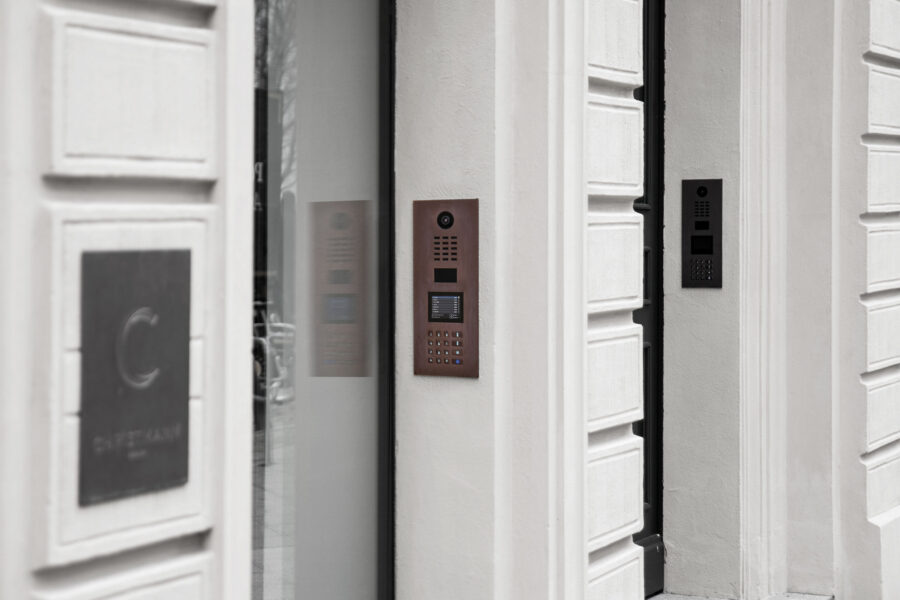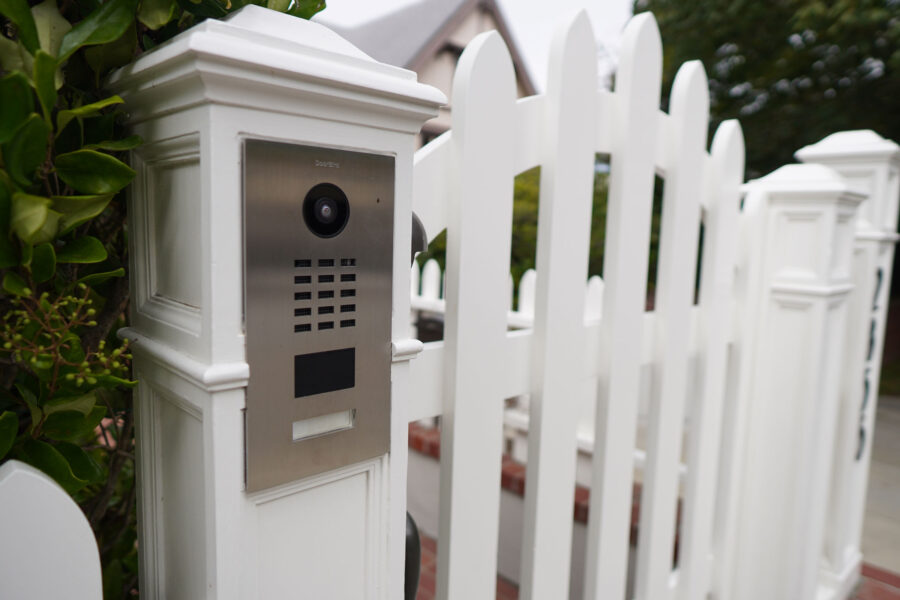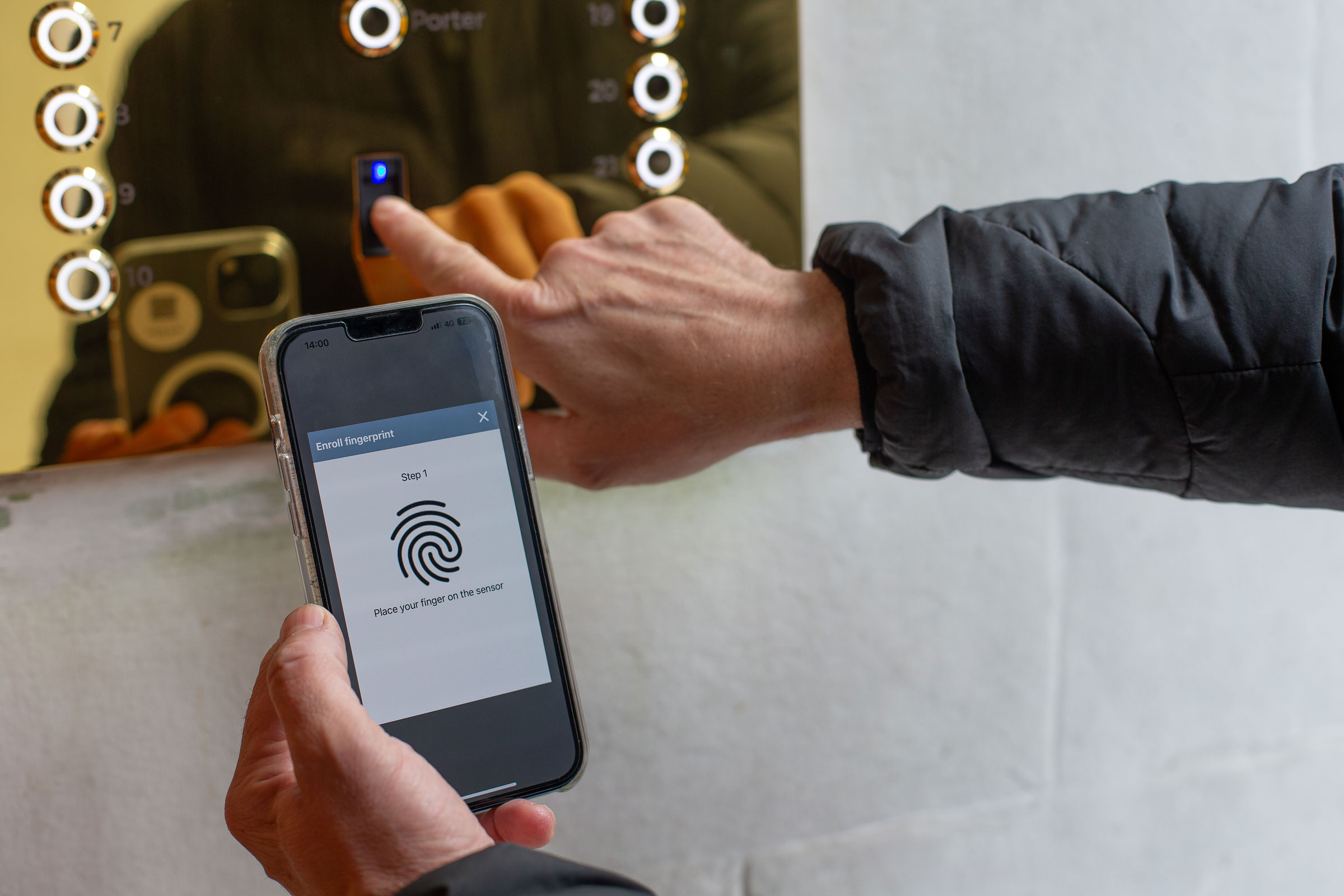Story at a glance:
- Top architects say access control has more aesthetic options than ever before.
- Mobile credentials are making people in multi-tenant buildings feel safer.
A crisp and clear microphone, HDTV video, a friendly chime, and even night vision—access control has come a long way from a knock on the door and a glance through a peephole. Today’s technology gives people almost instant information about who’s at their door, as well as a remote way to let them in if they so choose.
Access control is a key component of how Stantec designs safe buildings, according to Scott McChesney, senior project manager, technology, for Stantec. Cameras and how people enter a building are conversations that are had early on in the design process today, he says. “It’s one of the very first conversations that are had—because not only does access control control the building, but access control is changing and becoming more integral with smart buildings,” he says.
It’s important for architects to fully understand a door’s design needs early, for example, so they can also bring in a door hardware consultant early to get the proper hardware, says Misty Ryan-Gonzales, a project manager at Stantec. “Doors are super complicated,” she says.
Specialty locks are another consideration, McChesney says, including things like access control on exit routes and duress buttons at a hospital or school. Card credentials continue to get more secure, too, to protect against scams, and some video features take a timestamp so you know when someone enters and leaves a building. Delivery services can also be accommodated with temporary pins that expire after use. Features like mobile credentials on cell phones and video that pops up so you know who is at the door make people feel safer, McChesney says.
Aesthetics

The finishes and style around the intercom and how security is built into a building should be intentional and consistent with the look of the entrance, says DoorBird’s Justin Clark. Photo courtesy of DoorBird
The biggest change in access control in the last 25 years, though, is probably the reader itself. Designs today are much more beautiful and often fit seamlessly into projects. “There’s been a tremendous change in the aesthetics,” McChesney says. “I remember 10 or 15 years ago, they looked like somebody put a brick wall on the wall. That’s not so much the case anymore.”
Now there are stainless steel options and customizable covers, easily integrated for project consistency. Ryan-Gonzales remembers when Stantec worked on a wedding venue a few years ago that didn’t want cameras or security functions visible in the background of photos. “They wanted all of these different aspects of security to blend into the background,” she says. “That’s the part that’s really important to architects. They want the feeling of safety without seeing it.”
They want the feeling of safety without seeing it.
In previous years aesthetics may have been an afterthought in design, but not so anymore. “Security obviously is always necessary, but what’s happening now is individuals are starting to realize that it is necessary and there’s a lot you can do from an architectural perspective,” says Justin Clark, head of sales in the Americas, Australia, and New Zealand for DoorBird, who manufactures IP-based video door intercoms, access control devices, indoor stations, and accessories. DoorBird started in 2015 in San Francisco and is based in Germany; the brand was acquired by ASSA ABLOY, a global leader in access solutions, in 2022.
“Typically something that’s very high tech and very secure doesn’t always match the aesthetic desire of the developer, the architect, or the building owner,” Clark says. w“Design is becoming more focused when it comes to security products that hit the market. Specifically for what we do, that’s always been a focus—technology meets design. We believe firmly that we can create something that is technologically advanced and at the same time looks elegant and is consistent with the architecture of the building.”
Design conversations are increasingly including access control from the start. DoorBird offers a 3D configurator so design teams can imagine and customize their designs. “We have a configurator that allows you to create custom units, providing real-time pricing so you know what to expect, with more than 50 finishes, real bronze, burnished brass, and more colors. You can get it right and make sure it’s consistent with the other things you’re designing,” Clark says. “We’ve always had unique colors and finishes, but we really went full throttle in the design element about two to three years ago with the configurator.”
How DoorBird Works

Photo courtesy of DoorBird
When someone comes to a DoorBird door station, they hit a call button or search the directory for a name and dial the corresponding buttons. That user then receives a notification on their smartphone or at an indoor station, or, if in a commercial setting, potentially on an IP-based phone. The user can screen the person and decide if they want to speak to them or let them inside the building. The setup can be installed anywhere from an apartment building to a single-family home to hospitality or schools.
Since the technology is now network or IP-based, it can be installed anywhere. “You only need two wires to turn our product on,” Clark says. It’s also helpful in a retrofit scenario, as that means DoorBird can leverage existing wiring, as long as there are two wires, and get the device online and connected to the internet and users’ smartphones quickly. Of course, for folks who may not want smartphone access or who just also want an indoor station, too, that also continues to be an option. “Having an actual intercom device on the wall inside the apartment or a separate unit is still necessary in a lot of different applications. For instance, in a senior citizen type of living situation, having an indoor station is critical,” Clark says.
DoorBird’s indoor stations connect back to the door station through the cloud, making installation and even retrofits easy. “It also saves time and money,” Clark says.
McChesney says modern access control is a breath of fresh air. “It used to be that we were hampered by having one station in the field that had to have a direct connection back to, say, an office phone, so we were limited,” he says. “Now with mobile credentials they can log onto any computer on the network and interact with the intercom and buzz people in and out of the door. That’s another driving factor behind seeing intercoms being used on doors more than we used to.”
Security needs are ever-evolving, so what happens when technology needs to be updated? “With DoorBird it doesn’t mean we have to upgrade the whole unit. It just means we have to get inside the unit, get inside the cavity, and swap the internal module out. That’s way less expensive, with way less material that we have to replace time and again. That makes us quite unique in this space,” he says. “What we’re creating is not something you’re going to be replacing every season as soon as a newer product comes out.”
Instead of having to switch the intercom or the access control peripheral on the entrance, DoorBird can switch out modules with the latest technology while maintaining the existing hardware, whether that’s installed in stone cladding or set in a specific finish—things that are expensive to change. “That ability to create a true fixture definitely looks better, but then it’s also way more sustainable than switching something out every season.”
More Sustainability

Stainless steel materials and a design that’s meant to last makes solutions like these more sustainable. Photo courtesy of DoorBird
From a sustainability standpoint, design teams can also choose stainless steel, a highly recyclable material, for their covers, and, of course, when a module is designed to last, replacement materials are kept out of the landfill. “That’s going to be an enduring product on the building,” Clark says. “We’re really creating a fixture that stays on the building. Just as you might, for instance, find a certain sconce or lighting fixture on the outside that’s always going to be there; you just change out bulbs.”
Today DoorBird also reduces waste by sending only what is needed to customers, as opposed to sending power transformer options to meet various countries’ needs and letting teams choose; they send only what is necessary to reduce costs and waste.
The need for security certainly isn’t going anywhere, but access control should continue to become more user-friendly, Clark says. “People want to feel safe. Whether you’re at home or at work, you want to feel safe. It needs to become more user-friendly, and it needs to fit in with the world we see and how we want to see it. That design element is a factor there because it should look nice when you’re walking up to an entrance. It should blend in with everything else that’s going on. I think the more this becomes a status quo standard, the more we’ll find creative ways to make it fit with the world we want to see.”

